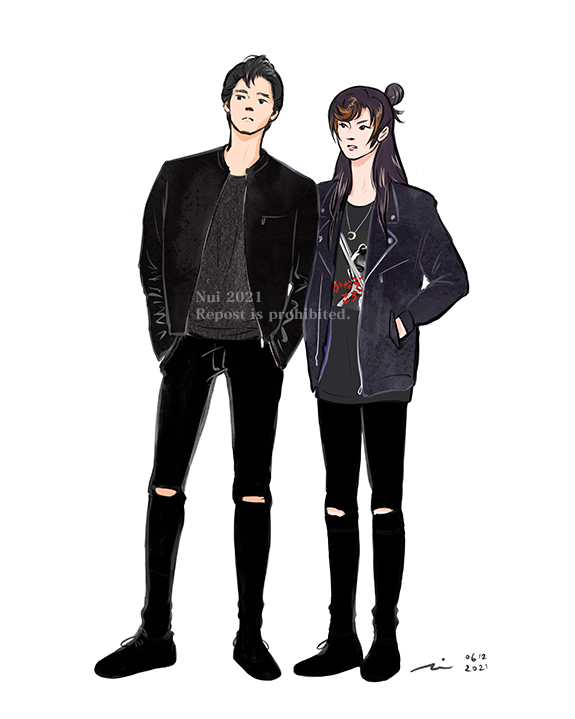日本の美術史における美男子
日本の美術史における美男子の定義は時代により変化するが、たおやかな稚児等が主役の中世から、江戸中期以降には「死」や「血」のにおい、鋭さが加わった。容姿は色白で柳腰、すっきりした顎、つり上がった眉と目で、闘いの気配もある。また戦前・戦中派までの武士道や、衆道等の色濃さも忘れてはならない。大正には高畠華宵(1888〜1966)の描く「死に向かう」美少年たちが人気を博したが、中性的な面立ちの彼らが傷つき、仲間と寄り添う姿は、男女ともに自己愛(ナルシシスム)と自己投影、嗜虐のエロスの眼差しを集めたようだ。Nuiはこれらの美意識を、日本の古典的な耽美と頽廃の美学と定義する。
同性に限らず、女性たちが鈴木春信(1725〜1770)の浮世絵に見られるような男女の区別がしにくい若衆に惹かれたのは、自分と似て自分にはない非現実的な存在だからという。男性も同じく、自己投影と女性の生理的な生々しさがないことを理由に男色を美化した。男も女も人間であり、性の境界線や拘りは薄かったと思われる。これらは互いに対立し依存し合いながら万物を形成しているという「陰陽論」に通底すると考える。
モチーフとしての時代劇俳優と「対」
Nuiは日本で古来より愛された美男子を現代に表現するべく、中性的な容姿の時代劇俳優を選んだ。「美男画」の要素には、美しい容姿以外にも精神性や生き方を求められる。時代が移ろうと、美男の在り方も封建主義的な美学に民主主義的な美学が加わったが、昭和から令和を生きる俳優たちは、そのどちらも体現できる稀有な存在だ。
さらに、中性的な美男子に、現代的で男性らしい時代劇俳優が並ぶことで「対」となる。悲劇性を愛し、元来中性的な男性に愛着を持ちながら、明治以降に西洋美術が流入してマスキュランな肉体美にも目覚めた日本人にとって、この陰陽的なコンビネーションはひとつの理想型だったのではないか。
日本の美男子の再定義
Nuiは彼らをモチーフに用いて、日本の美男子の概念を表現し、耽美・頽廃・陰陽をテーマに、願望と夢、現実と観念の統合と具現化を試みる。日本の美意識を表現してきた線画と、外国文化からインスパイアされるポップさと鮮やかな色を組み合わせることで、見る者の古めかしさへの抵抗を薄め、これらの美を現代に継承、あるいは蘇生する試みを追求する。
さらに国内で多様性に埋もれて形骸化されつつある美意識を海外に輸出することで文化継承を図り、若年層や外国人にも日本の耽美的な美の浸透・逆輸入を狙い、国内でふたたび時代劇が表現する美の見直しが行われることを願う。
Nui
令和6年7月18日
Statement (ENG)
Beautiful man in Japanese Art History
The definition of beauty in Japanese art history has changed with the times, from the Middle Ages, when graceful children and the like played the leading roles, to the mid-Edo period onward, when the scent of “death” and “blood” and sharpness were added. The appearance of the doll is pale, with a willowy waist, a slender chin, and lifted eyebrows and eyes, with a hint of combativeness. He also had a strong sense of bushido and shudo (the way of the samurai), which he had maintained before and during World War II. In the Taisho era (1912-1926), the “death” bishonen depicted by Takabatake Kashoi (1888-1966) became popular, and their neutral faces and the way they were hurt and cuddled with their friends seemed to attract narcissism, self-projection, and the erotic gaze of tastes for both men and women. and decadence.
Not only women of the same sex, but also women were attracted to young men and women who were difficult to distinguish from men and women, as in the ukiyoe paintings of Suzuki Harunobu (1725-1770), because they were unrealistic beings similar to themselves and not like themselves. Men likewise glorified masculinity because of self-projection and the lack of physiological rawness of women. Both men and women were human beings, and gender boundaries and preoccupations were thought to be thin. We believe that these are in common with the “yin-yang theory,” which holds that they form all things while opposing and depending on each other.
Samurai Drama Actors as Motifs and “One set”
Nui chose period drama actors with a neutral appearance to express the beauty men loved in Japan since ancient times in the modern age. In addition to beautiful appearance, the elements of art of a beautiful Japanese manrequire spirituality and a way of life. As the times have changed, a democratic aesthetic has been added to the feudalistic aesthetic of bisho, and actors from the Showa to the 2025 era are the rare ones who can embody both of these aesthetics. Furthermore, the neutral beauty of the male leads to a “pairing” with the modern and masculine period drama actors. This yin-yang combination may have been an ideal model for the Japanese, who loved tragedy and were originally attached to neutral men, but who were also awakened to masculine physical beauty with the influx of Western art after the Meiji period.
Inheriting or Reviving the Japanese Beautiful Boy
Nui uses them as motifs to express the concept of Japanese beautiful boy, and attempts to integrate and embody desire and dream, reality and conception, with themes of aestheticism, decadence, and yin-yang. By combining line drawings that have expressed the Japanese sense of beauty with pop and vivid colors inspired by foreign cultures, he seeks to diminish the viewer’s resistance to old-fashionedness and attempts to inherit or revive these beauties in the modern age. Furthermore, by exporting to foreign countries a sense of beauty that has been buried in diversity and is becoming a formality in Japan, we aim to pass on the culture to younger generations and foreigners, and to penetrate and reimport the aesthetic beauty of Japan to them.
